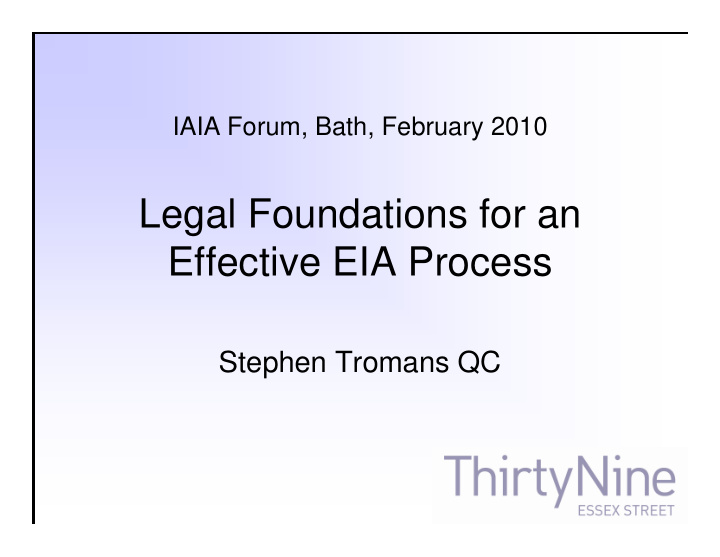



IAIA Forum, Bath, February 2010 Legal Foundations for an Effective EIA Process Effective EIA Process Stephen Tromans QC
The original objective Directive 85/337/EC, as amended, Recital 1: “The best environmental policy consists in preventing the creation of pollution or nuisances at source, the creation of pollution or nuisances at source, rather than subsequently trying to counteract their effects … the need to take effects on the environment into account at the earliest possible stage in all the technical planning and decision- making processes”
A further objective Directive 2003/35/EC on public participation, recital 3: “Effective public participation in the taking of decisions enables the public to express, and the decision maker to take account of, opinions and concerns which may be of, opinions and concerns which may be relevant to those decisions, thereby increasing the accountability and transparency of the decision-making process and contributing to public awareness of environmental issues and support for the decisions taken.”
The legal meaning of effectiveness • The effective protection of Community rights • The effective enforcement of Community law in the Community law in the national courts • The characteristics of Community law of primacy and direct effect • Article 10 of the EC Treaty and the duty of co-operation
Three aspects to effectiveness • Scope – the ambit of the Directive, and the screening process • Assessment – the technical process of EIA • Assessment – the technical process of EIA • Public participation – what information is the public provided with, when, and how decisions may be challenged
Scope • General theme of “wide scope and broad purpose” • Can be seen in legal approaches to interpreting approaches to interpreting descriptions of projects: e.g. Dutch Dykes; “urban development projects” ( Goodman ); use of “semi- natural areas” ( Wye Valley )
Screening • Consideration of cumulative effects in considering if significant effects likely • Tensions over use of • Tensions over use of thresholds by member states to exclude projects • How to approach proposed mitigating measures at screening stage
Difficulties of grafting EIA on to an established national system • Old mineral permission procedures ( Brown ) • Outline applications ( Tew and Milne ) • Approval of reserved matters • Approval of reserved matters ( Barker ) • Enforcement ( Prokopp ) • Retrospective permission ( Ardagh Glass ) • Matters outside planning regime
Technical effectiveness of EIA • By comparison with scope and procedural aspects, not an area the courts are keen to interfere in • Matters not addressed in ES on “wait and see” basis: Hardy • Alternatives: Challenger • Securing mitigating measures
Public participation • Provision of information (Art 6(2)) • Early and effective opportunity to participate in decision-making procedures when all options are open procedures when all options are open to decision-making authority (Art 6(4)) • Information and reasons for decision (Art 9(1)) • Access to review procedure (Art 10a)
Public participation • Reasons for screening decisions ( Mellor ) • Practical information on access to administrative and judicial review procedures ( Baker v. BANES ) procedures ( Baker v. BANES ) • Ability to drill down to raw information ( Finn-Kelcey ) • Access to internal reports of decision-maker ( Edwards/Pallikaropoulos )
Concluding thoughts • Effectiveness is a multi-faceted concept • It cannot be confined to technically expert assessment • EIA tends to be a legal • EIA tends to be a legal battleground for those opposing projects, but … • Ultimately EIA should be an aid and disciple to better decision- making, not a legal obstacle test
Recommend
More recommend